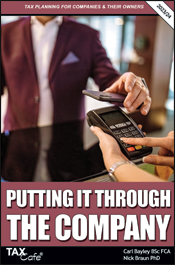Capital Allowances Guide
The Secret of Good Tax Planning Is Timing
From 1st April 2012 for companies, and 6th April 2012 for other businesses, the annual investment allowance will be reduced from £100,000 to just £25,000.
The latest information on all the expenses you can claim as a company owner, can be found in our popular guide:
Putting It Through the Company
There are important transitional rules that affect every business except:
- Companies with accounting periods ending on 31st March, and
- Other businesses with accounting periods ending on 5th April
A nasty ‘sting in the tail’ awaits anyone incurring significant qualifying expenditure between the date of the change and their next accounting year end.
For the most part, the transitional rules operate by a system of simple ‘time-apportionment’. For example, a company with a twelve month accounting period ending on 31st December 2012 will be able to claim a maximum annual investment allowance of:
£100,000 x 91/366 = £24,863
£25,000 x 275/366 = £18,784
Total = £43,647
This maximum annual investment allowance applies to the total expenditure in the accounting period, but an additional rule applies to restrict the amount of expenditure incurred after the date of the change.
For example, a company with a twelve month accounting period ending on 31st December 2012 can claim an annual investment allowance of up to £43,647, but no more than £18,784 of the qualifying expenditure can take place after 31st March 2012.
In the accompanying tables I have reproduced the maximum annual investment allowance claims applying to the most common accounting periods straddling the dates of change.
The first column gives the maximum annual investment allowance (AIA) for the whole accounting period. The second column gives the maximum annual investment allowance for the period from 1st or 6th April 2012 to the end of the accounting period.
The third column indicates the minimum amount of qualifying expenditure which needs to be incurred between the start of the accounting period and 31st March 2012 (or 5th April) in order for the business to be able to obtain the maximum annual investment allowance for the whole accounting period.
Clearly many businesses face a severe restriction on their capital allowances claims for the latter part of any transitional accounting period following the change.
Timing Your Expenditure
Timing your expenditure carefully during and after your transitional accounting period could lead to considerable tax savings. Where the business might potentially wish to spend in excess of these amounts, there are two basic choices:
- Accelerate the expenditure to before the date of change.
- Defer the expenditure until your next accounting period.
Example
Inglis Limited plans to spend £120,000 on plant and machinery qualifying for the general pool during the year ending 30th June 2012. If it spends the whole amount during the period between 1st April and 30th June 2012, it will be entitled to an annual investment allowance of just £6,216 and writing down allowances on the remainder. This will give the company total capital allowances for the year ending 30th June 2012 of just £28,415.
The balance of £91,585 carried forward on the company’s general pool will then generate further writing down allowances of £16,485 (at 18%) in the year ending 30th June 2013, giving the company total capital allowances over the two year period of £44,900.
Instead of this, however, the company brings forward £80,000 of its expenditure to March and defers a further £25,000 to July, spending only £15,000 between 1st April and 30th June 2012.
The company will now be able to claim the maximum annual investment allowance available for the year ending 30th June 2012: £81,352. This leaves just £13,648 of its expenditure of £95,000 during the year to fall into the general pool and attract writing down allowances of £2,663.
In the following year, the company will be able to claim an annual investment allowance of £25,000 on the expenditure which it deferred until July plus a further £1,977 in writing down allowances at 18%.
In summary, the company will now be able to claim total capital allowances of £110,992 over the two year period – £66,092 more than if it had incurred all of the expenditure in the period from April to June as originally intended.
Tax Savings
By timing its qualifying expenditure on plant and machinery carefully, Inglis Limited will be able to save between £13,218 and £17,839 in Corporation Tax over a two year period.
A higher rate taxpayer sole trader undertaking similar planning could save up to £34,368 over two years (at the current maximum combined rate of Income Tax and National Insurance: 52%).
If the plant and machinery described in the example had instead been integral features or other items falling into the special rate pool then Inglis Limited would have been able to save between £16,673 and £22,444 in Corporation Tax over the same two year period. A higher rate taxpayer sole trader could save up to £43,350!
Naturally, all of this is subject to the commercial requirements of the business. Nevertheless, whilst it is seldom worth spending money just to save tax, it may often be worth spending it a little sooner or a little later!






